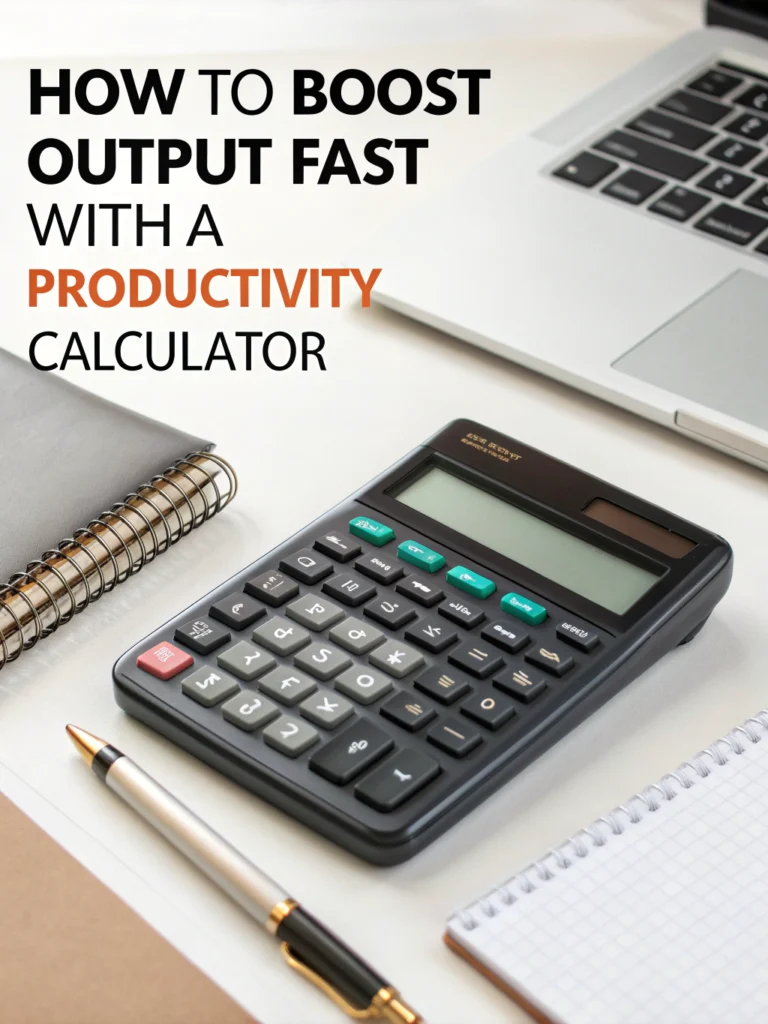How to Boost Output Fast with a Productivity Calculator
Ever feel like you're working non-stop but not actually getting anywhere? I've been there. The solution might be simpler than you think: a productivity calculator.
In today's fast-paced world, knowing exactly how to spend your time isn't just nice—it's necessary if you want to boost productivity fast. Let me show you how these calculators can transform your workday in minutes.
What Is a Productivity Calculator and Why It Matters
A productivity calculator is a tool that helps you measure, track, and optimize how efficiently you use your time. It's like having a personal efficiency expert that highlights where your time actually goes versus where you think it goes.
The truth? Most people overestimate their productive time by 25-30%. That's a massive gap that affects your bottom line, whether you're running a business or managing your personal goals.
Here's why these calculators matter:
- They turn subjective feelings about productivity into objective data
- They reveal your actual working patterns (often surprising)
- They help identify your peak performance times
- They create accountability through measurement
Types of Productivity Calculators That Actually Work
Not all productivity calculators are created equal. The best ones address different aspects of work efficiency:
1. Time Tracking Calculators
These tools track how you spend each minute of your workday, categorizing activities and showing you exactly where your time goes. The data often reveals shocking truths about how much time you spend on low-value activities.
2. Task Completion Rate Calculators
These measure how many planned tasks you complete versus how many you schedule. The completion percentage becomes your productivity score, which you can work to improve.
3. Focus Duration Calculators
These analyze how long you maintain deep focus before getting distracted. The longer your average focus sessions, the higher your output quality tends to be.
4. Energy Management Calculators
Rather than just tracking time, these tools help you identify when your energy levels are highest and suggest scheduling your most important work during those peak periods.
How to Improve Output with Calculator Tools in 5 Steps

Ready to transform your productivity? Here's my step-by-step approach:
Step 1: Select the Right Calculator for Your Needs
Different jobs require different measurement approaches. A writer might benefit most from a focus duration calculator, while a manager might need a task completion tracker. Choose tools that match your specific work challenges.
For most people, I recommend starting with a simple time tracking calculator like Toggl or RescueTime to establish your baseline.
Step 2: Gather Baseline Data
Run your chosen calculator for at least one week without changing anything about how you work. This establishes your productivity baseline—your starting point for improvement.
The data might be uncomfortable to see (most people are shocked by how much time they waste), but it's essential for making informed changes.
Step 3: Analyze Your Productivity Patterns
Look for these patterns in your data:
- When during the day you're most productive
- Which tasks consistently take longer than expected
- How much time you spend on low-value activities
- Your average focus duration before interruptions
Step 4: Implement Time Management Strategies Based on Data
Now that you have real data, implement targeted strategies:
- Schedule your most important work during your peak energy periods
- Batch similar tasks together to reduce context switching
- Set time limits for activities that tend to expand
- Create distraction-free blocks for deep work
Step 5: Continuous Measurement and Optimization
The most successful productivity improvers check their calculator data weekly. This isn't about obsessing over numbers—it's about creating a feedback loop that guides your work efficiency improvements.
Adjust your approach based on what the data shows is working. Small improvements compound dramatically over time.
Best Productivity Tools 2025 with Built-in Calculators
If you're ready to get serious about optimizing your output, these tools combine productivity calculation with practical features:
RescueTime Pro: Automatically tracks all your digital activities and scores your productivity, with distraction blocking features.
Toggl Track: Simple time tracking with detailed reporting and project management integration.
Focus App: Measures your focus sessions while blocking distractions and provides data on your concentration patterns.
Motion: AI-powered calendar that optimizes your schedule based on your productivity patterns and goals.
Clockify: Free time tracker with productivity analytics and team management capabilities.
For a comprehensive approach to using these tools effectively, check out the
>AI for Productivity eBook + Checklist: Supercharge Your Efficiency in 2179, which pairs perfectly with these calculator-based methods.
Advanced Tactics: How to Be More Productive with Calculator Data
Once you've mastered the basics, try these advanced approaches:
The 2X Productivity Formula
This method uses your calculator data to identify tasks that:
- Take twice as long as they should
- Could be delegated or automated
- Don't align with your highest-value activities
By eliminating, delegating, or optimizing these tasks, many users report doubling their productive output within weeks.
The Energy-Based Scheduling Method
Instead of a traditional to-do list, create an energy-based schedule that aligns with your productivity patterns:
- High-energy periods: Creative or complex work
- Medium-energy periods: Administrative or collaborative work
- Low-energy periods: Routine tasks or learning activities
Your calculator data reveals exactly when these periods occur for you personally.
The Focus Block Protocol
Create dedicated focus blocks based on your calculator's data about your optimal focus duration. If you tend to lose focus after 40 minutes, schedule 35-minute deep work sessions followed by 5-minute breaks.
This approach works particularly well for those with attention challenges. For more specialized strategies, the
>ADHD Productivity Power Pack: Ebooks, Guides, Checklists, Workbook & Tools to Master Focus, Time Management & Organization offers tailored solutions.
Common Productivity Calculator Mistakes to Avoid
Even with the best tools, certain mistakes can limit your results:
Measuring too many metrics at once: Start with just 1-2 key productivity indicators.
Aiming for perfection: Productivity isn't about maximizing every minute—it's about optimizing for what matters most.
Ignoring energy management: Time isn't your only resource; energy and attention are equally important.
Not accounting for different work types: Creative work has different productivity patterns than administrative work.
Forgetting about rest: The most productive people actually schedule more breaks and recovery time.
Integrating Calculators with Other Productivity Systems
For maximum impact, integrate your calculator data with other productivity systems:
- With Pomodoro Technique: Use your focus data to determine your optimal Pomodoro session length
- With GTD (Getting Things Done): Track how long different types of tasks actually take for better planning
- With Bullet Journaling: Add productivity scores to your daily logs for accountability
If you want to learn more about effective time management strategies, check out our productivity timer guide for complementary approaches.
Case Study: How I Used a Productivity Calculator to Double My Output
When I first tracked my productivity, I discovered I was only truly focused for about 2.5 hours in an 8-hour workday. Shocked? I was too.
Using a simple time tracker and focus calculator, I made these changes:
- Moved my most important work to my peak hours (9-11am)
- Implemented 50-minute focus blocks with 10-minute breaks
- Batch-processed emails twice daily instead of constantly checking
- Created a "no meetings" policy before noon
The results? Within 30 days, my focused work time increased to 5+ hours daily—effectively doubling my output without working longer hours.
For more ideas on optimizing your workspace to support these efforts, explore our guide on desk productivity tools that complement calculator-based approaches.
How Teams Can Use Productivity Calculators for Better Collaboration
Productivity calculators aren't just for individuals—they're powerful for teams too:
- Accurate project estimation: Use historical productivity data to make realistic timelines
- Workload balancing: Identify team members who are overloaded or underutilized
- Meeting optimization: Track meeting productivity scores to improve collaboration efficiency
- Resource allocation: Direct resources to high-impact activities based on productivity data
Many teams find that implementing shared productivity measurements leads to more equitable workloads and better communication around capacity.
If you're looking to improve your productivity while working remotely, our article on work from home productivity tools offers complementary strategies.
The Future of Productivity Calculation
The next generation of productivity tools 2025 is already emerging, with these exciting developments:
- AI-powered productivity coaches that analyze your data and suggest real-time optimizations
- Biometric productivity trackers that incorporate physical markers like heart rate variability
- Collaborative productivity networks that help teams synchronize their peak performance times
- Predictive analytics that forecast your productivity dips before they happen
These tools will make productivity calculation even more powerful and personalized.
Final Thoughts: Start Simple, Scale Gradually
The most effective approach to using a productivity calculator is to start small:
- Track just one aspect of your productivity (like focused work time)
- Make one change based on what you learn
- Measure the results
- Gradually add more sophisticated measurement as needed
Remember that productivity isn't about doing more—it's about achieving more of what matters. The right calculator doesn't just measure your time; it helps you make better decisions about how to invest it.
Ready to boost productivity fast? The simple act of measuring your current output with a calculator is often the catalyst that sparks significant improvement. Your productivity journey starts with knowing where you truly stand.
FAQs About Productivity Calculators
What's the simplest productivity calculator for beginners?
For absolute beginners, I recommend Toggl Track for its one-click time tracking and simple reports that show where your time goes without overwhelming you with data.
How accurate are productivity calculators?
Modern digital productivity calculators are extremely accurate for tracking time and task completion. However, measuring subjective elements like work quality requires additional assessment tools.
Can productivity calculators help with work-life balance?
Yes! Many people find that seeing their actual working hours helps them maintain boundaries. Some calculators specifically track work vs. personal time to ensure balance.
Do I need to pay for a good productivity calculator?
No. While premium tools offer more features, excellent free options like Clockify provide robust productivity measurement capabilities that are sufficient for most users.
How often should I review my productivity data?
For optimal results, review your high-level productivity metrics weekly and do a deeper analysis monthly. This frequency provides actionable insights without becoming obsessive about the numbers.
Can productivity calculators help with ADHD or focus issues?
Absolutely. Many people with attention challenges find that calculators provide the external structure and accountability that helps them stay on track. They make patterns visible that might otherwise be missed.

